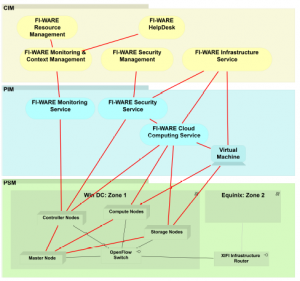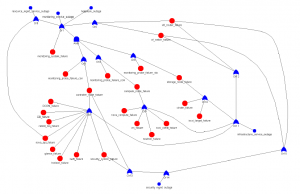There are many different technologies which can increase availability of a cloud infrastructure. In our newest Techcouting paper we evaluate several HA technologies in order to define a HA architecture for an OpenStack deployment which is part of the XiFi project. HA technologies can be grouped in the following classes:
- Resource monitors that check if IT-services are alive and (sometimes automatically) recover them in case of failure.
- Load balancers that direct end user requests to those resources that are still alive and show reasonable prformance.
- Distributed disks and file systems that increase redundancy of data and help to prevent data loss in case of failure.
- Distributed databases which help to prevent loss of database records.
Every OpenStack component has the purpose to deliver a service to an end user. Availability of a cloud instance is dependent on the availability of the delivered end users services as perceived by end users. If we want to use a HA technology to increase availability of OpenStack we have to analyze dependencies of end user services on IT and infrastructure components. Therefore we created a dependability model of the provided IT services and the business services consumed by end users.
As availability always depends on the requirements that are defined by end users we asked several OpenStack end users in a survey on the importance of each business service. The result is that end users tended to rate “Infrastructure Management” and “Security Management” as the most important services. Therefore we had to ensure that these services have high availability levels.
By linking the importance of the service to the IT components that provide it, we can assign a target availability level to each component. Furthermore we can compare several HA architectures to each other and check the availability levels they can achieve. We built several fault tree diagrams that represent the link of component failures to service outages:
A simulation of service outages by given inputs of failure rates revealed that adding HA technologies to OpenStack can add up to 7-8 percent points to the average availability level of the provided services.
We tested several technologies that belong to one of the HA technology classes. Our evaluation included chances and risks associated with implementing the technology and technological maturity. We assigned each technology a chances, risks and maturity score.
The result of our evaluation is that we prefer to use keepalived, HAProxy, Ceph/RADOS and MySQL Galera as HA technologies to improve availability of our OpenStack installation. These technologies are all open-source. They have been preferred because their performance is not significantly lower than the performance of commercial products, but they are available for free, while commercial products are not. The final HA architecture is able to increase availability levels of all OpenStack services up to three nines – which is a very high availability level in cloud computing.
It is clear that another organization would come to other conclusions when the concrete implementation of a HA technology has to be selected, but the evaluation methodology used in our paper shows how to make more reasonable technology choice decisions by linking end user requirements with system architecture characteristics and rate several architectural alternatives by the availability levels that are reasonably achievable.


